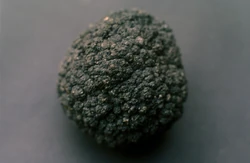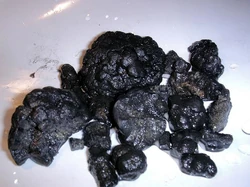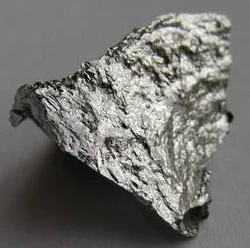
Manganese nodule.

Nodules on the Seabed.

Polymetallic nodules. Author: Marcin Zych, uploader: JCh.

Manganese from the collection of elements by Tomi Hahndorf. Author: Tomihahndorf.
The mineral[]
Manganese has no satisfactory substitute in its major applications in metallurgy.In minor applications, (e.g., manganese phosphating), zinc and sometimes vanadium are viable substitutes.
Polymetallic nodules, also called manganese nodules, are rock concretions on the sea bottom formed of concentric layers of iron and manganese hydroxides around a core. The core may be microscopically small and is sometimes completely transformed into manganese minerals by crystallization. When visible to the naked eye, it can be a small test (shell) of a microfossil (radiolarian or foraminifer), a phosphatized shark tooth, basalt debris or even fragments of earlier nodules.
Nodules vary in size from tiny particles visible only under a microscope to large pellets more than 20 centimetres (8 in) across. Most nodules (which are between 3 and 10 cm (1 and 4 in) in diameter) lie on the seabed sediment, often partly or completely buried.
Their surface textures vary from smooth to rough. They are frequently have botryoidal (mammilated or knobby) texture and vary from spherical to typically oblate, sometimes prolate, or otherwise irregular. The bottom, buried in sediment, is generally rougher than the top due to a different type of growth.
The average nodule has 24% manganese, iron (14%), copper (1%), nickel (1%), cobalt (0.25%) and traces of some other metals like platinum and titanium, along with hydrogen and oxygen, as well as the water of crystallization and free water. The land based ores (manganite, purpurite, rhodonite, rhodochrosite, pyrolusite, mineraloids such as psilomelane and wad) contain 35% to 55% manganese. Those of greatest economic interest contain manganese (27-30%), nickel (1.25-1.5 %), copper (1-1.4 %) and cobalt (0.2-0.25 %). Other constituents include iron (6%), silicon (5%) and aluminium (3%), with lesser amounts of calcium, sodium, magnesium, potassium, titanium and barium, along with hydrogen and oxygen, as well as the water of crystallization and free water.
As nodules can be found in vast quantities in plaves, and contain valuable metals, deposits were identified as having economic interest in the 1960s by John Mero.
Formation[]
These nodules are thought to form when chemicals dissolved in seawater precipitate onto a small object on the sea bed. Leading theory state chemical reactions in seawater that are boosted by microbes, in a similar way as at underwater hot springs and the natural precipitation of excess metal from seawater. Manganese and iron from underwater volcanic eruptions can also contribute to nodule growth, as can the presence of algae and bacteria.
They grow at the extremely slow rate of just a few millimeters per million years, yet they have regularly seen growing in lakes, reservoirs and on sunken ship wrecks from both world wars.
Timeline of events.[]
In the 1860s[]
The first known Polymetallic nodules were discovered in 1868 in the Kara Sea, in the Arctic Ocean of Siberia.
In the 1870s[]
During the scientific expeditions of the HMS Challenger (1872–1876), they were found to occur in most oceans of the world.
In the 1890s[]
A few were found in Chile's Littoral waters and washed up on beaches.
From the 1890s to 1920s[]
No further research is done or finds made.
In the 1930s[]
Several patches of Polymetallic nodules were found in the Baltic Sea. Japanese troops and fishermen encountered some in the TTPI.
In the 1940s[]
Japanese troops and fishermen encountered some in the TTPI.
In the 1950s[]
American troops and fishermen encountered some in the TTPI. Several more patches of Polymetallic nodules were found in the Baltic Sea and several parts of the central Pacific.
In the 1960s.[]
Serious test dredging and research in the Pacific was proposed by experts like John Mero.
In the 1970s[]
The world was gripped by new scientific ideas, a sense of corporate risk, the need for new resources, a sense of submarine adventure and the belief that if humans could do anything if they tried hard enough. Nauru, Kiribati and Tonga found massive reserves. Lesser amounts were found around Midway Island, Northern Hawaii, French Polynesia, Pitcairn Island and Easter Island.
Mining it was a hot topic at the time, but interest eventually waned by the late 1980s.
GSF Explorer[]
GSF Explorer, formerly USNS Hughes Glomar Explorer (T-AG-193), was a deep-sea drillship platform initially built for the United States Central Intelligence Agency Special Activities Division secret operation Project Azorian to recover the sunken Soviet submarine K-129, lost during April 1968. It claimed to be mining Manganese nodules.
The cultural effect of Glomar Explorer is indicated by its reference to a number of books: The Ghost from the Grand Banks, a 1990 science fiction novel by Arthur C. Clarke; Shock Wave by Clive Cussler; Charles Stross's novel, The Jennifer Morgue; and The Hunt for Red October by Tom Clancy.
In the 1980s[]
The total amount of polymetallic nodules on the sea floor was estimated at 500 billion tons by Alan A. Archer of the London Geological Museum in 1981. The difficulty of the submarine in mining the ocean depths and the technological advances early 1980s in extracting ores on land had terminated interest on economic grounds by the late 1980s.
In the 1990s[]
Some were found around Diego Garcia in the Indian Ocean. Polymetallic nodules were found in some deep lakes and growing on ship wrecks from WW1 and WW2 in the mid-Atlantic and central Pacific oceans respectively.
In the 2000s[]
It became popular at this time due to the increasing need for minerals, high prices and advancing technology.
In the 2010s[]
British UK Seabed Resources Limited and the Belgian G-TEC Sea Mineral Resources NV. are looking in to mining it. Nauru, Kiribati and Tonga are interested in handing out mining concessions.
Mid-Atlantic nodules are found in the tropical ocean depths between South America and Africa.
Occurrence[]
Most nodules (which are between 3 and 10 cm (1 and 4 in) in diameter) lie on the seabed sediment, often partly or completely buried. They vary greatly in abundance, in some cases touching one another and covering more than 70% of the sea floor. The total amount of polymetallic nodules on the sea floor was estimated at 500 billion tons by Alan A. Archer of the London Geological Museum in 1981.
Polymetalic nodules are found in both shallow (e.g. Baltic Sea) and deeper waters (e.g. central Pacific), even in lakes, and are thought to have been a feature of the seas and oceans at least since the deep oceans oxidised in the Ediacaran period over 540 million years ago.
Polymetallic nodules were discovered in 1868 in the Kara Sea, in the Arctic Ocean of Siberia. During the scientific expeditions of the HMS Challenger (1872–1876), they were found to occur in most oceans of the world.
- Their composition varies by location, and sizeable deposits been found in four areas:
- Penrhyn Basin near within the Cook Islands.
- North central Pacific Ocean in a region called the Clarion Clipperton Zone (CCZ) roughly midway between Hawaii and Clipperton Islands.
- The largest of the deposits in terms of nodule abundance and metal concentration occur in the Clarion Clipperton Zone on vast abyssal plains in the deep ocean between 4,000 and 6,000 m (13,000 and 20,000 ft). The International Seabed Authority estimates that the total amount of nodules in the Clarion Clipperton Zone exceeds 21 Bt of nodules containing more than 270 Mt of nickel, 5.95 Bt of manganese, 234 Mt of copper and 46.6 Mt of cobalt. This manganese nodule belt within the Clarion-Clipperton Fracture Zone, northeast equatorial Pacific.
- Peru Basin in the southeast Pacific .
- Southern tropical Indian Ocean in a region termed the Indian Ocean Nodule Field (IONF) roughly 500 km SE of Diego Garcia Island.
- The Marshall Islands was found since the 1960s to have untapped phosphate deposits, marine products and deep seabed minerals like manganese nodules.
- Palau was found since the 1960s to have mostly untapped forests, minerals (especially gold), marine products, deep-seabed minerals minerals like manganese nodules.
- The Federated States of Micronesia was found since the 1960s to have mostly untapped forests, marine products, deep-seabed mineral minerals like manganese nodules.
- Wake Island was initially thought to have some, but this was later disproved as no more than the odd scattered individuals in the island's exclusive ecanomic zone (EEZ).
All of these deposits are mostly in international waters apart from the Penrhyn Basin, which lies within the exclusive economic zone of the Cook Islands.
The newly found mid-Atlantic nodules in tropical ocean depths between South America and Africa resided in depth of between 16,400 feet and 18,000 feet (5,000 and 5,500 meters).
Exploitation[]
Legal developments in 'The Area'[]
After the Second World War the United Nations started a lengthy process of developing international treaties that moved away from the then held concept of Freedom of the seas.
By 1972, the promise of nodule exploitation was one of the main factors that led developing nations to propose that the deep seabed beyond the limits of national jurisdiction should be treated as a “common heritage of mankind”, with proceeds to be shared between those who developed this resource and the rest of the international community. This initiative eventually resulted in the adoption (1982) of the United Nations Convention on the Law of the Sea (UNCLOS) and after negotiation of Part XI by 1994, the establishment of the International Seabed Authority, with responsibility for controlling all deep-sea mining in international areas. The first legislative achievement of this intergovernmental organization was the adoption (2000) of regulations for prospecting and exploration for polymetallic nodules, with special provisions to protect the marine environment from any adverse effects. The Authority followed this up (2001-2002) by signing 15-year contracts with seven private and public entities, giving them exclusive rights to explore for nodules in specified tracts of the seabed, each 75,000 square kilometers in size. The United States, whose companies were among the key actors in the earlier period of exploration, remains outside this compact as a non-party to the Law of the Sea Convention. Per UNCLOS the Authority has four main functions. Essentially these are:
- To administer the mineral resources of the seabed in the Area;
- To enact rules, regulations and procedures relating to these resources;
- To promote and encourage marine scientific research and development in the Area;
- To protect and conserve the natural resources of the Area and prevent significant damage to the environment.
Currently the International Seabed Authority is defining and debating aspects of its Mining Code which encompasses Polymetallic Sulphides (Seafloor massive sulphide deposits) and Cobalt-Rich Crusts as well as Polymetallic Nodules. The Mining Code includes exploration and draft exploitation regulations, an Environmental Management Plan for the Clarion Clipperton Zone, and recommendations for the guidance of Contractors in terms of reporting, environmental impact assessment, expenditure reporting and training for scientists and engineers from developing nations.
In addition to the Convention on Biological Diversity; on 19 June 2015 the General Assembly of the UN adapted resolution A/RES/69/292 - Development of an international legally-binding instrument under the United Nations Convention on the Law of the Sea on the conservation and sustainable use of marine biological diversity of areas beyond national jurisdiction.[18] This resolution calls for a PrepCom to be established to examine what this instrument could look like and what it would address specifically in addition to the existing environmental parts of UNCLOS. It would take into account the various reports of the Co-Chairs on the work of the relevant Ad Hoc Open-ended Informal Working Group. In due course an intergovernmental conference would review and debate the recommendations of the PrepCom.
Mining plans and methods[]
Researchers became interested in mining the minerals in the early 1970s, since the contained valuable metals such as nickel, copper and cobalt, but the of the difficulty submarine in mining the ocean depths and the technological advances early 1980s in extracting ores on land had terminated interest on economic grounds by the late 1980s.
The average nodule has 24% manganese, iron (14%), copper (1%), nickel (1%), cobalt (0.25%) and traces of some other metals like platinum and titanium. The land based ores (manganite, purpurite, rhodonite, rhodochrosite, pyrolusite, mineraloids such as psilomelane and wad) contain 35% to 55% manganese. Those of greatest economic interest contain manganese (27-30%), nickel (1.25-1.5 %), copper (1-1.4 %) and cobalt (0.2-0.25 %). Other constituents include iron (6%), silicon (5%) and aluminium (3%), with lesser amounts of calcium, sodium, magnesium, potassium, titanium and barium, along with hydrogen and oxygen as well as water of crystallization and free water.
Environmental issues and sensitivities[]
Any future mining of nodules in The Area needs to be authorised by the International Seabed Authority and would need to quantify impact in advance via an Environmental impact statement and associated Environmental Management Plan. These assessments, monitoring plans and guidance controls would likely work at the scale of proposed operations.
The International Seabed Authority already has an Environmental Management Plan that considers the entire Clarion Clipperton Zone and that includes reference areas that are not available for mining (termed Areas of Particular Environmental Interest).
Environmental assessments would need to have an unbiased scientific basis, and to account for:
the remote nature of the nodules making detailed data collection challenging; the large variety in scale (e.g. sub decimeter nodule communities spread over thousands of kilometers) in terms of ecosystem function and biodiversity; the severity and scale of local impacts (such as habitat removal, resedimentation). Past environmental studies such as the Deep Ocean Mining Environmental Study (DOMES) and resultant Benthic Impact Experiments (BIE) concluded in part that trial mining at a reasonable scale would likely help best constrain real impacts from any commercial mining.
Research shows that polymetallic nodule fields are hotspots of abundance and diversity for a highly vulnerable abyssal fauna. Nodule mining could affect tens of thousands of square kilometers of these deep sea ecosystems. Nodule regrowth takes decades to millions of years and that would make such mining an unsustainable and nonrenewable practice. Any prediction about the effects of mining is extremely uncertain. Thus, nodule mining could cause habitat alteration, direct mortality of benthic creatures, or suspension of sediment, which can smother filter feeders. Future environmental impact studies should address the impact on disruption and release of methane clathrate deposits in the deep oceans.
Proposed usage[]
They would be mined and refined like ordenery manganese ore. Manganese has no satisfactory substitute in its major applications in metallurgy.In minor applications, (e.g., manganese phosphating), zinc and sometimes vanadium are viable substitutes.
2015\2016 prices and abundance[]
- Nickel (2015):
- Abundance earth’s crust: 84 parts per million by weight, 30 parts per million by moles
- Abundance solar system: 80 parts per million by weight, 2 parts per million by moles
- 2015 cost, pure: $7.7 per 100g
- 2015 cost, bulk: $1.9 per 100g
- Copper (2015):
- Abundance earth’s crust: 60 parts per million by weight, 19 parts per million by moles
- Abundance solar system: 700 parts per billion by weight, 10 parts per billion by moles
- Cost, pure: $9.76 per 100g
- Cost, bulk: $0.66 per 100g
- Uranium (2015):
- Abundance earth’s crust: 2.7 parts per million by weight, 0.25 parts per million by moles
- Abundance solar system: 1 part per billion by weight, 4 parts per trillion by moles
- 2015 cost, pure: $ N\A per 100g
- 2015 cost, bulk: $9 per 100g
- Gold (2015):
- Abundance earth’s crust: 4 parts per billion by weight, 0.4 parts per billion by moles
- Abundance solar system: 1 part per billion by weight, 10 parts per trillion by moles
- 2015 cost, pure: $5,540 per 100g
- 2015 cost, bulk: $3,800 per 100g
- Manganese (2016):
- Abundance earth’s crust: 0.1% by weight, 360 parts per million by moles
- Abundance solar system: 10 parts per million by weight, 0.2 parts per million by moles
- Cost, pure: $6.5 100g
- Cost, bulk: $0.28 per 100g
- Iron (2016):
- Abundance earth’s crust: 5.6 % weight, 2.1 % by moles
- Abundance solar system: 1000 parts per million by weight, 30 parts per million by moles
- Cost, pure: $7.2 per 100g
- Cost, bulk: $0.02 per 100g
- Titanium (2016):
- Abundance earth’s crust: 0.56% by weight, 0.25% by moles
- Abundance solar system: 4 parts per million by weight, 100 parts per billion by moles
- Cost, pure: $661 per 100g
- Cost, bulk: $ per 100g
- Cobalt (2016):
- Abundance earth’s crust: 25 parts per million by weight, 8 parts per million by moles
- Abundance solar system: 4 parts per million by weight, 0.7 parts per million by moles
- Cost, pure: $21 per 100g
- Cost, bulk: $4.40 per 100g
World Manganese production[]

World Manganese Production in 2006.
.
Also see[]
- Mining
- Nickel
- Wake Atoll
- Useful metals
- Midway Island
- Johnston Atoll
- Energy and resources
- Minerals and fuel in central Africa
- Trust Territory of the Pacific Islands
- Mineral mining, smelting, processing and shipping videos!
Sources[]
- https://en.wikipedia.org/wiki/Manganese_nodule
- http://kgov.com/list#manganese-nodules
- http://www.isa.org.jm
- https://www.isa.org.jm/biodiversity-0
- https://www.ugent.be/en/news-events/news/polymetallic-nodule-fields-are-required-to-preserve-abyssal-fauna
- http://www.classbrain.com/cb_cr/fields/natural_resources.html
- https://www.cambridge.org/core/journals/environmental-conservation/article/div-classtitlethe-deep-sea-floor-ecosystem-current-status-and-prospects-of-anthropogenic-change-by-the-year-2025div/39F27935EE1A96180A5D8B4E32D91B83
- https://www.isa.org.jm/mining-code
- http://www.icr.org/article/8650/
- http://creation.com/manganese-nodules
- http://www.sciencemall-usa.com/manoforsa.html
- http://worldoceanreview.com/en/wor-3-overview/mineral-resources/manganese-nodules/
- https://en.wikipedia.org/wiki/Manganese_nodule
- https://www.hsph.harvard.edu/mining/files/ENVIRONMENTAL_ASPECTS_OF_MANGANESE_NODULE_MINING.pdf
- http://worldoceanreview.com/en/wor-3-overview/mineral-resources/manganese-nodules/
- https://www.wikiwand.com/en/Manganese
- http://worldoceanreview.com/en/wor-3-overview/mineral-resources/manganese-nodules/2/
- http://www.livescience.com/49820-manganese-nodules-atlantic-ocean.html
- http://worldoceanreview.com/en/wor-3-overview/mineral-resources/manganese-nodules/
- http://creation.com/manganese-nodules
- https://www.wikiwand.com/en/Manganese_nodule
- http://worldoceanreview.com/en/wor-3-overview/mineral-resources/manganese-nodules/2/
- http://www.classbrain.com/cb_cr/fields/natural_resources.html
- http://www.livescience.com/49820-manganese-nodules-atlantic-ocean.html
- http://www.sciencemall-usa.com/manoforsa.html
- http://www.icr.org/article/8650/
- http://worldoceanreview.com/en/wor-3-overview/mineral-resources/manganese-nodules/
- http://creation.com/manganese-nodules
- https://quizlet.com/51066640/marine-biology-flash-cards/
- http://geology.uprm.edu/Morelock/resdeep.htm
- http://www.wow.com/wiki/Manganese_nodule
- http://www.sciencemall-usa.com/mano1.html
- https://en.wikipedia.org/wiki/Manganese_nodule
- http://creation.com/manganese-nodules
- http://www.sciencemall-usa.com/mano1.html
- https://www.hsph.harvard.edu/mining/files/ENVIRONMENTAL_ASPECTS_OF_MANGANESE_NODULE_MINING.pdf
- http://geology.com/usgs/manganese/
- http://atoztheusa.blogspot.co.uk/2013/04/northern-mariana-islands-mineral.html
- http://www.sciencemall-usa.com/manoforsa.html
- https://en.wikipedia.org/wiki/Manganese_nodule
- https://images.search.yahoo.com/search/images?p=Mariana+islands+minerals+deposit&fr=yset_chr_cnewtab&imgurl=http%3A%2F%2Foos.soest.hawaii.edu%2Fpacioos%2Fimages%2Fi_mariana_webpic.jpg#id=1&iurl=https%3A%2F%2Fwalrus.wr.usgs.gov%2Fresearch%2Fprojects%2Fimages%2Fpotential_res.gif&action=click
- http://www.popsci.com/scientists-find-unexpected-ore-deposit-middle-atlantic
- http://worldoceanreview.com/en/wor-3-overview/mineral-resources/manganese-nodules/
- https://walrus.wr.usgs.gov/research/projects/pac_eez_minerals.html
- http://www.chiefscientist.gov.au/2010/10/what-lurks-crawls-and-swims-beneath-the-first-ever-marine-census-has-the-answers/
- https://en.wikipedia.org/wiki/Littoral_zone
- http://www.infomine.com/countries/mining-peru
- https://en.wikipedia.org/wiki/Mineral_industry_of_Peru
- http://www.chemicool.com/elements/nickel.html
- http://www.chemicool.com/elements/uranium.html
- http://www.chemicool.com/elements/gold.html
- http://www.chemicool.com/elements/copper.html
- http://www.chemicool.com/elements/iron.html
- http://www.chemicool.com/elements/manganese.html
- https://en.wikipedia.org/wiki/Manganese_nodule
- http://www.blue-nodules.eu/
- http://www.livescience.com/49820-manganese-nodules-atlantic-ocean.html
- http://www.sciencemall-usa.com/manoforsa.html
- http://www.icr.org/article/8650/
- http://worldoceanreview.com/en/wor-3-overview/mineral-resources/manganese-nodules/
- http://creation.com/manganese-nodules
- https://quizlet.com/51066640/marine-biology-flash-cards/
- http://geology.uprm.edu/Morelock/resdeep.htm
- http://www.wow.com/wiki/Manganese_nodule
- http://www.sciencemall-usa.com/mano1.html
- https://en.wikipedia.org/wiki/Manganese_nodule
- http://creation.com/manganese-nodules
- http://www.sciencemall-usa.com/mano1.html
- https://www.hsph.harvard.edu/mining/files/ENVIRONMENTAL_ASPECTS_OF_MANGANESE_NODULE_MINING.pdf
- http://geology.com/usgs/manganese/
- http://www.chemicool.com/elements/titanium.html
- https://en.wikipedia.org/wiki/Manganese_nodule
- http://www.chemicool.com/elements/cobalt.html